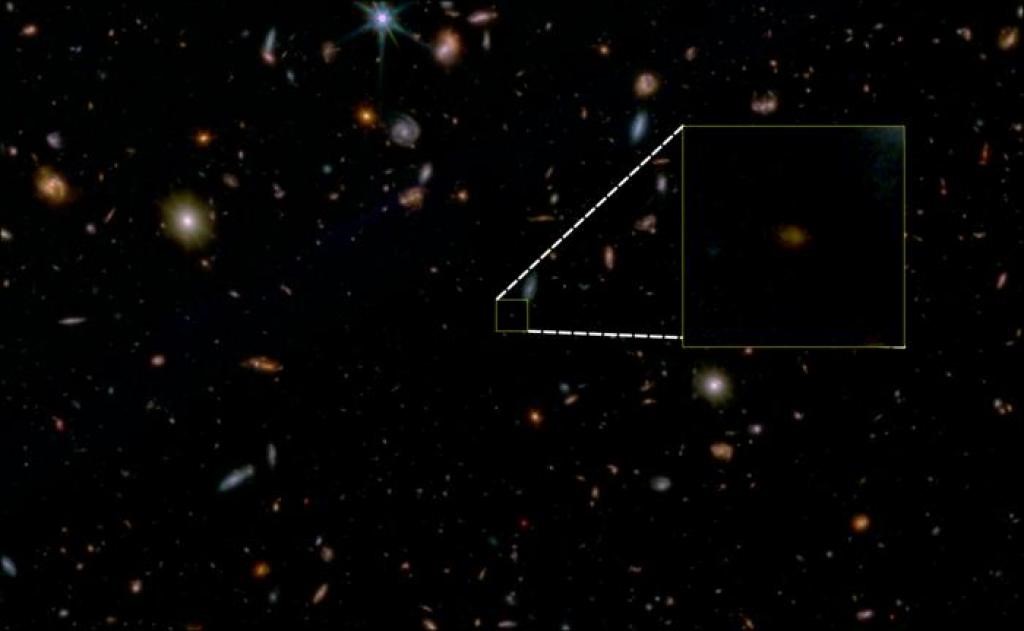Description

Disclaimer: Copyright infringement not intended.
Context
The James Webb Space Telescope (JWST) has recently made a groundbreaking discovery, capturing the image of the oldest-known dead galaxy in the universe. This galaxy ceased star formation approximately 13 billion years ago, shedding light on the enigmatic process of galactic evolution.
Details
Unveiling the Ancient Galaxy
- The dead galaxy was observed when the universe was merely 700 million years old, indicating its early formation and demise.
- It underwent a rapid phase of star formation lasting between 30 and 90 million years before abruptly halting its stellar activity.
Implications for Astrophysics
- The findings offer valuable insights into the mechanisms governing star formation and cessation in galaxies over billions of years.
- Understanding the factors influencing the cessation of star formation is a fundamental challenge in modern astrophysics, and this discovery contributes significantly to addressing this issue.
Comparison with Previous Observations
- Previous observations by the Hubble telescope identified six massive dead galaxies that lost the cold hydrogen gas necessary for star formation.
- The newly discovered dead galaxy, with its higher redshift and lower mass, adds to our understanding of galactic evolution and diversity.
Galactic Evolutionary Processes
- Star formation can be halted by various factors, including internal mechanisms such as supermassive black holes and feedback from stellar activity.
- Gas depletion, either due to expulsion by internal forces or lack of replenishment from external sources, can lead to the cessation of star formation in galaxies.
Insights into Early Universe Dynamics
- The early universe witnessed vigorous star formation fueled by abundant gas reservoirs, akin to an "all-you-can-eat buffet" for galaxies.
- As the universe evolved, galaxies transitioned from active star-forming phases to dormant states, possibly influenced by the interplay of internal and external factors.

What is a Galaxy?
- Definition: A galaxy is a massive system comprising billions to trillions of stars, along with interstellar gas, dust, and dark matter, bound together by gravity.
- Types of Galaxies:
- Spiral Galaxies: Characterized by a flat, rotating disk with spiral arms, such as the Milky Way.
- Elliptical Galaxies: Elliptical or oval-shaped collections of stars, lacking spiral arms.
- Irregular Galaxies: Galaxies with no distinct shape, often the result of gravitational interactions with neighboring galaxies.
- Size and Scale: Galaxies vary widely in size, from dwarf galaxies with only a few billion stars to giant galaxies hosting trillions of stars.
Structure and Components of Galaxies:
- Stellar Population: Galaxies consist of different populations of stars, ranging from young, hot stars in star-forming regions to older, cooler stars in galactic cores.
- Interstellar Medium (ISM): The ISM comprises gas and dust between stars, crucial for forming new stars and influencing galactic evolution.
- Dark Matter: Invisible, mysterious matter that comprises a significant portion of a galaxy's mass and plays a crucial role in its dynamics and structure.
Formation and Evolution of Galaxies:
- Early Universe: Galaxies began forming shortly after the Big Bang, with gravitational clumping of matter leading to the formation of protogalactic clouds.
- Hierarchical Assembly: Galaxies grow through mergers and interactions with neighboring galaxies, leading to the formation of larger structures.
- Star Formation: Galaxies undergo periods of intense star formation, fueled by gravitational collapse of gas clouds and triggered by interactions with other galaxies.
- Galactic Dynamics: The gravitational interactions within galaxies, including the role of dark matter, govern their evolution and morphology over cosmic timescales.
Observational Techniques and Studies:
- Optical Astronomy: Traditional telescopes observe galaxies in visible light, revealing their shapes, colors, and internal structures.
- Radio and Infrared Astronomy: Observations in radio and infrared wavelengths provide insights into the distribution of gas, dust, and star formation within galaxies.
- Spectroscopy: Analyzing the light emitted or absorbed by galaxies reveals their chemical composition, kinematics, and evolutionary history.
- High-Energy Astronomy: X-ray and gamma-ray observations probe the energetic processes, such as black hole accretion and supernova explosions, occurring within galaxies.
Current Research and Future Prospects:
- Galaxy Formation Simulations: Computational models simulate the formation and evolution of galaxies, incorporating factors such as gas dynamics, star formation, and feedback mechanisms.
- Multiwavelength Surveys: Ongoing surveys, such as the Sloan Digital Sky Survey and the Hubble Deep Field, provide vast datasets for studying galaxy populations and cosmic evolution.
- Next-Generation Observatories: The James Webb Space Telescope and ground-based facilities like the Extremely Large Telescope promise to revolutionize our understanding of galaxies with unprecedented resolution and sensitivity.
About the Small Magellanic Cloud (SMC)
- Definition: The Small Magellanic Cloud is a dwarf irregular galaxy located near the Milky Way, named after the Portuguese explorer Ferdinand Magellan who first documented it during his voyage in the early 16th century.
- Distance and Size: The SMC is situated approximately 200,000 light-years away from Earth and spans about 7,000 light-years in diameter.
- Galactic Neighborhood: Along with its larger companion, the Large Magellanic Cloud (LMC), and the Milky Way, the SMC is part of the Local Group of galaxies.
Structure and Composition:
- Stellar Population: The SMC hosts a diverse population of stars, ranging from young, massive stars in star-forming regions to older, cooler stars in its central regions.
- Gas and Dust: Interstellar gas and dust clouds pervade the SMC, serving as the raw material for ongoing star formation processes.
- Star Clusters: The SMC contains numerous clusters of stars, including open clusters and globular clusters, which provide valuable insights into its evolutionary history.

Star Formation and Evolution:
- Active Star Formation: Despite its relatively small size, the SMC exhibits vigorous star formation activity, with young, luminous stars illuminating its spiral arms and nebulae.
- Trigger Mechanisms: Interactions with the Milky Way and the LMC, as well as gravitational instabilities within the SMC itself, contribute to the ongoing formation of stars and stellar clusters.
- Evolutionary Trajectory: The SMC's evolution is influenced by its interactions with neighboring galaxies, leading to complex dynamics and morphological changes over cosmic timescales.
Notable Features and Objects:
- Nebulae and Supernova Remnants: The SMC is adorned with a plethora of nebulae, including the Tarantula Nebula, one of the largest H II regions in the Local Group, and supernova remnants such as the N19 complex.
- Magellanic Bridge and Stream: The SMC is connected to the LMC and the Milky Way via a bridge of gas and stars, providing evidence of past interactions and ongoing gravitational influences.
- Variable Stars: The SMC is a rich hunting ground for variable stars, including Cepheids, RR Lyrae stars, and eclipsing binaries, which serve as standard candles for cosmic distance measurements.
MUST READ ARTICLES:
https://www.iasgyan.in/daily-current-affairs/stellar-halo-31#:~:text=JWST%20will%20study%20various%20phases,Sun%E2%80%93Earth%20L2%20Lagrange%20point.
|
PRACTICE QUESTION
Q. Galaxies are the cosmic laboratories where stars are born, evolve, and die, shaping the evolution of the universe. Discuss. 150 Words.
|














